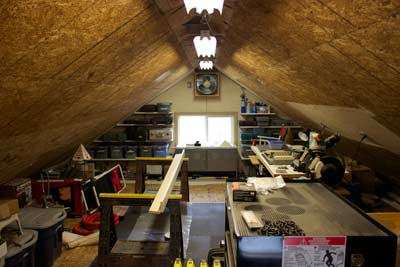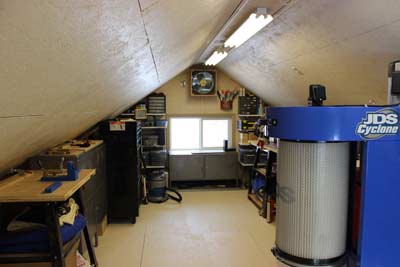
 by Steven D. Johnson
by Steven D. Johnson
Racine, Wisconsin
(Page 4 of 4)
Previous Page
1
2
3
4
Installation of a Central Dust Collection System (Pt. 3 of a Series)
Click on any picture to see a larger version.


|
|
Figure 18 - Installing the dust collector forced me to purge, clean, and paint... now I just wish I had done it sooner!
|
The new dust collection system installation is complete in the Down To Earth Woodworking shop. In the video released this week the details of the static dissipation system are covered, and in two weeks we will release a final wrap-up and tour of the complete system, along with performance measurements and an overall review of the JDS 2100-CKV Dust Collector. Be sure to watch for that video.
The dust collector is installed in the upstairs of my shop, a challenging area with limited space and headroom. As the part of my shop that was never quite finished like the downstairs area, the dust collection system forced me to transform the space and it turned out pretty well. The space is clean, organized, and brighter now, and while I do little there other than store tools and jigs and sharpen chisels and plane irons, it is now a much more pleasant and productive space.
The installation of the entire system took about sixty hours of work after prepping the area. It took only one day to assemble the dust collector but took four long days to install the ductwork. Another two days were spent installing and testing the static discharge system. The amount of time spent installing the system made me realize that dust collection is exactly that… a "system." And to effectively mitigate dust in the workshop we should consider it a "holistic system," meaning that the component parts are interconnected and the aggregate efficiency is interrelated. In short, the chain is only as strong as its weakest link.
Dust collection as a "holistic system" depends on (a) efficient capture at point of generation, (b) efficient transport through the ductwork system, (c) efficient separation of all manner and sizes of wood chips and sawdust from the air, and (d) collection of the collected dust and chips in a way conducive to disposal or recycling. Breaking down the dust collection system into four distinct component processes allows us to be a bit more pragmatic about our goals.
Next month in the Down To Earth Woodworking shop we will be looking at a product intended to reduce machine vibration, the design process for both an indoor and outdoor bench, and we are making a set of pet steps that double as convenient storage. Look forward to seeing you!
(Page 4 of 4)
Previous Page
1
2
3
4
Steven Johnson is retired from an almost 30-year career selling medical equipment and
supplies, and now enjoys improving his shop, his skills, and his designs on a full time basis
(although he says home improvement projects and furniture building have been hobbies for most of his
adult life).
Steven can be reached directly via email at downtoearthwoodworks@me.com.
Return to Wood News front page
